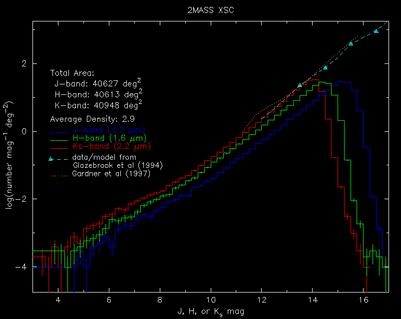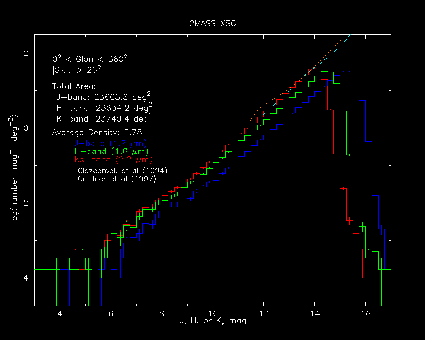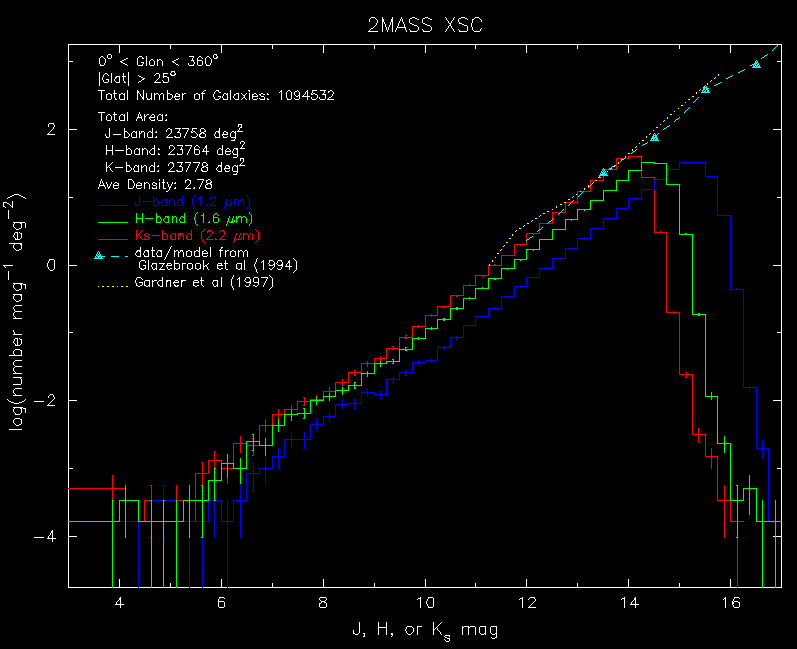2MASS XSC Source Counts
Differential source counts (logN vs. logS) for the XSC
are presented below. The sky is divided into four Galactic zones:
|Glat| > 25 deg
10 < |Glat| < 25
5 < |Glat| < 25
|Glat < 5 deg
The first zone represents the clearest view of the extragalactic Universe,
subject to minimal stellar confusion noise and mostly free of
Galactic (Milky Way) contamination. The final three zones comprise
the traditional "Zone of Avoidance", characterized by significant confusion
noise
(and hence lower sensitivity for detection) and contamination from Milky Way stars.
See the discussion on
confusion noise and stellar number density.
The source counts for zones 1 and 2 (i.e., |Glat| > 10 deg) are
a direct measure of the galaxy counts in the local Universe.
But only Zone 1 (i.e., |Glat| > 25 deg) is subject to the Level-1 Science Requirements
for galaxy completeness and reliability.
For zones 3 & 4 (i.e., |Glat| < 10),
the source counts are a mixture of galaxies and Milky Way extended objects:
Extended sources associated with the Galaxy are highly
confined to the Galactic Plane (see for example the
All Sky Distribution of XSC Sources),
and include HII regions, nebulosity, star formation regions (with Young Stellar
Objects) and other deeply embedded Milky Way objects.
See also
Visual Inspection of Extended Sources for examples of the kinds of extended sources within the
XSC.
The photometry used for constructing the source counts is
the fiducial elliptical isophotal
(20 mag arcsec-2 in the Ks band)
integrated fluxes. These mags represent approximatetly
85% of the total flux of a galaxy; see
Large Aperture Photometry: Profile Fitting, Isophotal & Total Mags.
a. All Sky Source Counts for XSC
b. All Sky Source Counts for XSC Galaxies
Here the known Galactic sources have been removed, leaving only
galaxies in the differential source counts.
c. Cluster Source Counts
Here the known Galactic sources have been removed, leaving only
galaxies in the differential source counts.
See the
All Sky Map for a locations of clusters
-
Movie showing the XSC galaxy counts for the field and clusters (Virgo,A262,A3627,Coma,A2052,Hercules,A3558,A2670,A2721)
-
Virgo Cluster of Galaxies; z = 0.004
-
Abell 262 Cluster of Galaxies; z = 0.016 (Perseus-Pisces Supercluster)
-
Abell 3627 Cluster of Galaxies, Great Attractor Field; z = 0.016
-
Coma Cluster of Galaxies; z = 0.023
-
Abell 2052 Cluster of Galaxies; z = 0.035
-
Hercules Cluster of Galaxies; z = 0.037
-
Abell 3558 Cluster of Galaxies; z = 0.048
-
Abell 2670 Cluster of Galaxies, z= 0.075
-
Abell 2721 Cluster of Galaxies, z= 0.114
[Last Updated: 2003 Jan 29; by Tom Jarrett]




